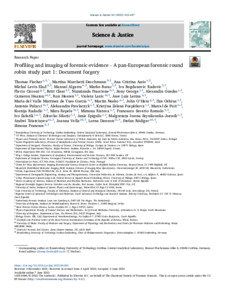FISCHER, T., MARCHETTI-DESCHMANN, M., CRISTINA ASSIS, A., LEVIN ELAD, M., ALGARRA, M., BARAC, M., BOGDANOVIC RADOVIC, I., CICCONI, F., CLAES, B., FRASCIONE, N., GEORGE, S., GUEDES, A., HEATON, C., HEEREN, R., LAZIC, V., LUIS LERMA, J., DEL VALLE MARTINEZ DE YUSO GARCIA, M., NOSKO, M., O'HARA, J., OSHINA, I., PALUCCI, A., PAWLACZYK, A, ZELENÁ POSPÍŠKOVÁ, K., DE PUIT, M., RADODIC, K., RĒPELE, M., RISTOVA, M., SAVERIO ROMOLO, F., ŠAFAŘÍK, I., SIKETIC, Z., SPIGULIS, J., IWONA SZYNKOWSKA-JOZWIK, M., TSIATSIUYEU, A., VELLA, J., DAWSON, L., RÖDIGER, S. and FRANCESE, Simona
(2022).
Profiling and imaging of forensic evidence – a pan-European forensic round robin study part 1: document forgery.
Science and Justice, 62 (4), 433-447.
[Article]
Documents
30482:606405
![[thumbnail of Francese-ProfilingImagingForensic(VoR).pdf]](https://shura.shu.ac.uk/30482/2.hassmallThumbnailVersion/Francese-ProfilingImagingForensic%28VoR%29.pdf)

Preview
Abstract
The forensic scenario, on which the round robin study was based, simulated a suspected intentional manipulation of a real estate rental agreement consisting of a total of three pages. The aims of this study were to (i) establish the amount and reliability of information extractable from a single type of evidence and to (ii) provide suggestions on the most suitable combination of compatible techniques for a multi-modal imaging approach to forgery detection. To address these aims, seventeen laboratories from sixteen countries were invited to answer the following tasks questions: (i) which printing technique was used? (ii) were the three pages printed with the same printer? (iii) were the three pages made from the same paper? (iv) were the three pages originally stapled? (v) were the headings and signatures written with the same ink? and (vi) were headings and signatures of the same age on all pages? The methods used were classified into the following categories: Optical spectroscopy, including multispectral imaging, smartphone mapping, UV-luminescence and LIBS; Infrared spectroscopy, including Raman and FTIR (micro-)spectroscopy; X-ray spectroscopy, including SEM-EDX, PIXE and XPS; Mass spectrometry, including ICPMS, SIMS, MALDI and LDIMS; Electrostatic imaging, as well as non-imaging methods, such as non-multimodal visual inspection, (micro-)spectroscopy, physical testing and thin layer chromatography. The performance of the techniques was evaluated as the proportion of discriminated sample pairs to all possible sample pairs. For the undiscriminated sample pairs, a distinction was made between undecidability and false positive claims. It was found that none of the methods used were able to solve all tasks completely and/or correctly and that certain methods were a priori judged unsuitable by the laboratories for some tasks. Correct results were generally achieved for the discrimination of printer toners, whereas incorrect results in the discrimination of inks. For the discrimination of paper, solid state analytical methods proved to be superior to mass spectrometric methods. None of the participating laboratories deemed addressing ink age feasible. It was concluded that correct forensic statements can only be achieved by the complementary application of different methods and that the classical approach of round robin studies to send standardised subsamples to the participants is not feasible for a true multimodal approach if the techniques are not available at one location.
Actions (login required)
 |
View Item |



 Tools
Tools Tools
Tools